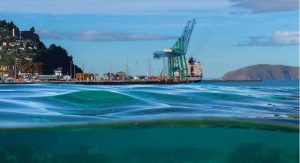Carbon reduction progress
LPC has measured its Scope 1 and 2 emissions and some of its Scope 3 emissions since 2018. We have seen a slight decrease in these emissions since 2021, mostly due to investment in fuel-efficient Noell straddles and the purchase of certified renewable electricity (eliminating Scope 2 emissions).
In FY23, we reviewed our Emissions Reduction Plan. This included a high-level analysis of the initiatives the business could implement to achieve near-term science-based emissions reduction targets for Scope 1 emissions. We identified five significant reduction initiatives that replace diesel-powered plant and equipment with electric alternatives.
Looking ahead to FY24 and beyond, the implementation of these initiatives would set LPC on a solid course towards achieving near-term science-based emissions reduction targets by 2030.
FY23 emissions
LPC’s total emissions for FY23 were 9,422 tCO₂e – about 500 tonnes over our target and just a slight reduction from last year.
Last year saw us make good progress in improving operational efficiency and reducing our carbon emissions per TEU even though we handled record container volumes. This year, the container terminal handled 455,562 TEU – a 9% decrease from FY22. In the same period, carbon emissions per TEU increased by 13%. This increase in emissions per TEU is likely due to changes in our terminal layout. FY23 saw the reconfiguration of the terminal with the Eastern Development expansion. This meant that, although we handled fewer containers, our straddle travel distances increased.
In FY23, we also saw the full return of cruise to our business, and two tugs are now used for most of our container vessel movements. This contributed to an overall increase in emissions from our marine fleet.
Progress on infrastructure carbon
In FY23, we began developing a framework to quantify, track and ultimately reduce embodied carbon in our infrastructure projects. We saw this successfully implemented in our new maintenance workshop, Te Whare Whakatika. We compared the embodied carbon footprint across two floor types – cross-laminated timber (CLT) and concrete rib and infill.
The preferred solution was CLT, resulting in total upfront carbon of negative 30,000 kg and 10% less 20-year whole-of-life greenhouse gas emissions. There was also a saving to the build of approximately $25,000 using this type of flooring.
Looking ahead
Looking ahead, we will increase our focus on indirect emissions reporting, baseline setting and considering reduction targets for Scope 3 (value chain) emissions. It is expected that LPC’s Scope 3 emissions, measured in accordance with the Greenhouse Gas Protocol, will far exceed our Scope 1 emissions, highlighting the importance of aligning with a science-based target commitment.
Waste
In FY23, we were under our target of 359,280 kg, generating 338,580 kg of waste to landfill.
Liquid waste accounted for over half of our waste to landfill. This is actually a good thing, as keeping our stormwater interceptors clean is essential for maintaining their efficiency and protecting the health of the harbour and our city waterways. We have also added two new wash bays at Te Whare Whakatika for washing straddles and in the inner harbour for bulk cargo cleaning. As a result, an increase in liquid waste is expected over the next 12 months.
Biodiversity
We are aiming to achieve biodiversity positive status across our area of operations and are working in partnership with Te Hapū o Ngāti Wheke to set aspirational goals for what biodiversity positive looks like in Whakaraupō/Lyttelton Harbour.
Using the science-based targets for nature framework, we made good progress over the last financial year to identify Port activities at our Lyttelton site that have an impact on nature. For each activity, including dredging, reclamation, vessel movements and occupation of the land, there are associated pressures on nature and varying impacts on habitats and species. There are also some activities we can identify as having a positive impact on nature, including restoration and habitat enhancement.
As we work through the steps in the framework, we are also developing how traditional knowledge and perspectives can form part of our assessments. Te Hapū o Ngāti Wheke hold mātauranga (knowledge) that will inform aspirations for a healthy harbour and can assist with what we measure to indicate positive change over time.
Advice from environmental management consultancy Nature Positive has assisted our progress to date. Over the next financial year, we will outline the risks of nature loss to LPC’s business and the opportunities for action. We will continue to work with Te Hapū o Ngāti Wheke to assess, quantify and report the impacts LPC has on nature and develop a plan for achieving biodiversity positive status.
